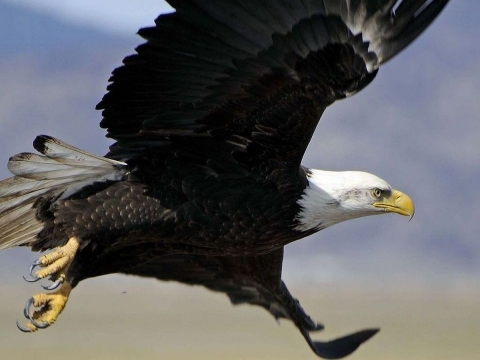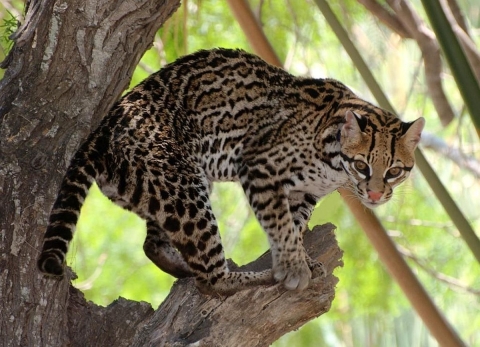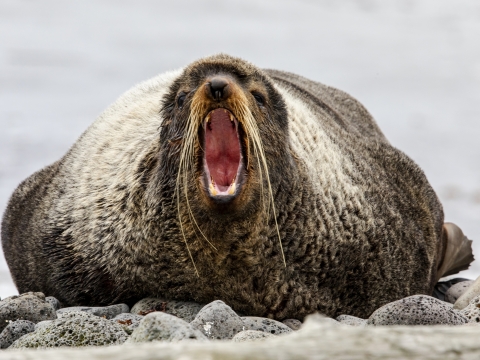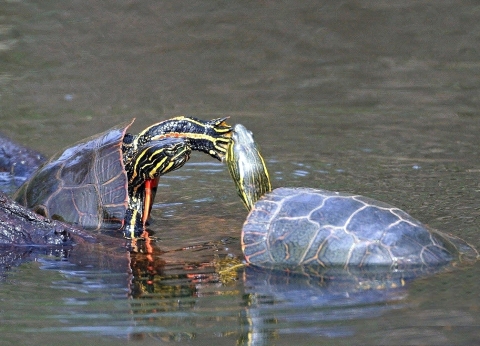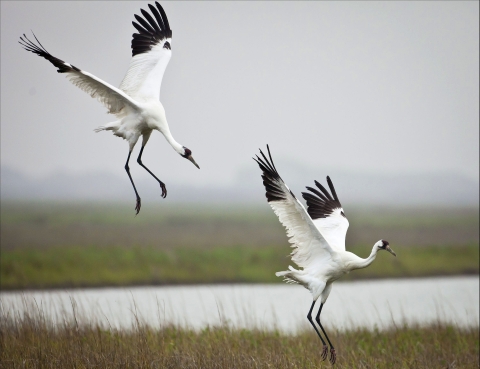The U.S. Fish and Wildlife Service conserves land and water on national wildlife refuges for more than 700 species of birds, 220 species of mammals, 250 reptile and amphibian species, and more than 1,000 species of fish. Here’s a sampling of them, from A to Z.
A is for alligators. Alligators have survived for 200 million years. In the 1950s, American alligator populations reached all-time lows, primarily because of market hunting and habitat loss. However, by 1987, the alligator was pronounced fully recovered, making it one of the first endangered species success stories. Today, alligators are found throughout the Southeast, from the Carolinas to Texas and north to Arkansas.
B is for bison. The bison is our national mammal. Once, millions of bison roamed North America, but by the 1800s only a few hundred were left in the United States after settlers pushed bison to near extinction. Since then, bison have recovered and can be seen at Colorado’s Rocky Mountain Arsenal National Wildlife Refuge, Oklahoma’s Wichita Mountains Wildlife Refuge, Iowa’s Neal Smith National Wildlife Refuge and others. 15 facts about bison.
C is for cats. National wildlife refuges provide territory for felines of all kinds, including lynx, bobcats, mountain lions and panthers. Florida Panther National Wildlife Refuge, east of Naples, Florida, was established to protect its endangered namesake. Florida panthers once roamed the Southeast. Today they are limited to a single breeding population of approximately 120 to 230 adults and subadults in south Florida.
D is for ducks. Ducks, geese, swans and waterfowl of all kinds are plentiful at national wildlife refuges along North America’s four migratory bird flyways (Atlantic, Mississippi, Central and Pacific). Refuges and wetland management districts are vital to the Prairie Pothole Region of the Dakotas, Minnesota and eastern Montana, which has been called “the duck factory of America.”
E is for eagles. Half a century ago, the bald eagle was in danger of extinction from habitat loss, illegal shooting and food source contamination. Conservationists and government helped lead a remarkable recovery, aided by passage of the Endangered Species Act in 1973. The bald eagle was removed from the federal list of threatened and endangered species in 2007. This photo essay touches on why the bald eagle inspires the awe and respect it does.
F is for fish. The U.S. Fish and Wildlife Service conserves natural areas for more than 1,000 species of fish. Working with tribes, states, landowners and other partners, in 2020 the National Fish Hatchery System released more than 98 million adult and juvenile fish from 65 native species into various waters in 44 states. National wildlife refuges are chock-full of freshwater and saltwater recreational fishing opportunities. For more information and tips, please go to the fishing section of the Visit the National Wildlife Refuge System page.
G is for grasshoppers. Grasshoppers, other insects — and microorganisms, too — play an often-underappreciated role in keeping the world ecologically healthy. They thrive on national wildlife refuges. Fun fact: Grasshoppers can jump more than 20 times their body length.
H is for hummingbirds. Hummingbirds and other pollinators, such as bees, butterflies and bats, are vital to people. We owe most of our fruits, crops and flowers to pollinators. They carry pollen from flower to flower, fertilizing them in the process and helping to feed the planet.
I is for ibis. Ibis are among the hundreds of thousands of beautiful waterbirds and shorebirds that nest, rest, feed and/or breed in wetlands, marshes and coastal shorelines at national wildlife refuges.
J is for jays. The Cornell Lab of Ornithology lists at least nine species of jays in the United States.Blue jays inhabit the nation’s eastern two-thirds. California scrub jays are found up and down the Pacific Coast, including at Sacramento National Wildlife Refuge. They are considered particularly intelligent.Steller’s jays are common in the mountain west. Florida scrub jays live in isolated populations in that state, including at Merritt Island National Wildlife Refuge. Green jays can be seen at Santa Ana, Laguna Atascosa and Lower Rio Grande Valley National Wildlife Refuges in Texas.
K is for killdeer. These attractive brown-ish birds are known for a patch of zebra-like black-and-white bands of coloring. Members of the plover family, killdeer are found at wildlife refuges across the nation. They get their name from their sharp call. Have a listen here. Honestly, we don’t hear the “kill deer” thing. Do you?
L is for lizards. Rare St. Croix lizards are found at Green Cay National Wildlife Refuge in the Virgin Islands, and similarly uncommon blunt-nosed leopard lizards inhabit Kern National Wildlife Refuge in California. Chuckwallas — desert lizards known to be at Ash Meadows National Wildlife Refuge in Nevada — have a pretty cool defense: They protect themselves by inflating their bodies while in rock crevices, making it difficult for predators to grab them.
M is for manatees. Manatees, sometimes called sea cows or teddy bears of the sea, are found in warm, shallow, slow-moving rivers, estuaries, saltwater bays and coastal areas. They cannot survive well in water colder than 68 degrees. Manatees gather at Crystal River National Wildlife Refuge in Florida year-round, but are most plentiful there from November through March.
N is for nene. Nene, also known as the Hawaiian goose, is the state bird of Hawaii. Several national wildlife refuges are working to help this endangered species recover: Kilauea Point and Hanalei on Kaui, James Campbell on Oahu and Hakalau Forest on the Big Island.
O is for ocelots. Ocelots once ranged from south Texas into Arkansas and Louisiana. Today only an estimated 50 ocelots remain in the United States, including a breeding population at Laguna Atascosa National Wildlife Refuge. In Texas, organizations and citizens are working to save endangered ocelots. There’s even a special Save Texas Ocelots car license plate to raise awareness.
P is for pinnipeds. That’s the scientific term for seals, sea lions, walruses and other meat-eating marine mammals. Pinnipeds haul out of the water to rest at national wildlife refuges along the West Coast, including Farallon Islands National Wildlife Refuge in California, Three Arch Rocks National Wildlife Refuge in Oregon, San Juan Islands National Wildlife Refuge in Washington and Togiak National Wildlife Refuge in Alaska.
Q is for quail. Six species of quail are native to the United States. The most common is the northern bobwhite quail. The rarest is the endangered masked bobwhite quail, which is being bred in captivity at Arizona’s Buenos Aires National Wildlife Refuge and released into restored native grasslands.
R is for red-cockaded woodpeckers. These birds once were common across the Southeast. Now the largest population of the endangered red-cockaded woodpecker is at Carolina Sandhills National Wildlife Refuge in South Carolina. Private landowners and nonprofit organizations are working with the U.S. Fish and Wildlife Service to restore longleaf pine forests on which red-cockaded woodpeckers and other iconic species rely.
S is for snakes. There are roughly 3,000 species of snake in the world, but only 100 or so in the United States. While snakes get a bad rap, most are harmless. And they do control rodent and tick populations. Snakes to avoid because their venom is poisonous are coral snakes, rattlesnakes, copperheads and cottonmouth.
T is for turtles. National wildlife refuges and turtles are made for each other. Just a sampling: Archie Carr National Wildlife Refuge in Florida is one of the most important nesting places in the world for loggerhead sea turtles. Sandy Point National Wildlife Refuge in the Virgin Islands is similarly important to leatherback sea turtles. Alligator snapping turtles are common at Oklahoma’s Sequoyah National Wildlife Refuge. Blanding’s turtles are conserved at Assabet River, Oxbow and Great Meadows National Wildlife Refuges in Massachusetts.
U is for ungulates. That’s the fancy term for deer, caribou, elk, sheep, pronghorn and other hoofed mammals. Deer are common at refuges from coast to coast. Arctic National Wildlife Refuge in Alaska is particularly important to caribou. Bighorn sheep and Rocky Mountain elk roam the mountain west. Species of pronghorn can be found at Oregon’s Malheur National Wildlife Refuge, Arizona’s Cabeza Prieta National Wildlife Refuge and many refuges in between.
V is for Virginia rails. We could have chosen vireos or vultures here, but went with Virginia rails because we like that they are slightly odd. These rust-colored chicken-like birds with orange-ish bills prefer walking to flying, and they are famously secretive. They tend to hide in freshwater marshes at national wildlife refuges from coast to coast.
W is for whooping cranes. All whooping cranes alive today descend from the last 15 remaining cranes found wintering in 1941 at Aransas National Wildlife Refuge on the Gulf of Mexico in Texas. The only natural flock — now about 500 birds — still winters at Aransas Refuge. Each spring the cranes migrate 2,500 miles north to nest at Wood Buffalo National Park in Canada. Whooping cranes are big. At about five feet in height, they are considered North America’s tallest bird, and their wingspan is more than seven feet. They are monogamous and mate for life.
X is Xerces blue butterflies. Xerces blue butterflies were last seen in the early 1940s. The species was one of the first American butterflies to become extinct because of human activities. Today, the Xerces Society, an international nonprofit organization, “protects wildlife through the conservation of invertebrates and their habitats.” Invertebrates – animals without a backbone – include butterflies and other insects, spiders, worms, scorpions and snails.
Y is for yellowthroats. In spring and summer, common yellowthroats are often found in national wildlife refuge national wildlife refuge
A national wildlife refuge is typically a contiguous area of land and water managed by the U.S. Fish and Wildlife Service for the conservation and, where appropriate, restoration of fish, wildlife and plant resources and their habitats for the benefit of present and future generations of Americans.
Learn more about national wildlife refuge marshes and wetlands everywhere. One hazard these songbirds face is brood parasitism. This occurs when a bird of one species lays its eggs in the nest of a bird of another species and leaves the responsibility of rearing the offspring to the other bird. Brown-headed cowbirds often lay their eggs in the nests of common yellowthroats and sometimes steal the yellowthroats’ eggs.
Z is for zebra mussels. These freshwater mussels are an aquatic invasive species invasive species
An invasive species is any plant or animal that has spread or been introduced into a new area where they are, or could, cause harm to the environment, economy, or human, animal, or plant health. Their unwelcome presence can destroy ecosystems and cost millions of dollars.
Learn more about invasive species that threatens the health of inland waters and other mussel species. Brought here from Europe in ships’ ballast water, zebra mussels were first discovered in the Great Lakes region in 1988. Zebra mussels have inflicted tremendous damage to native ecosystems and to facilities that use water, such as power plants and municipal water suppliers. Millions of dollars have been spent to control and eradicate zebra mussels.



